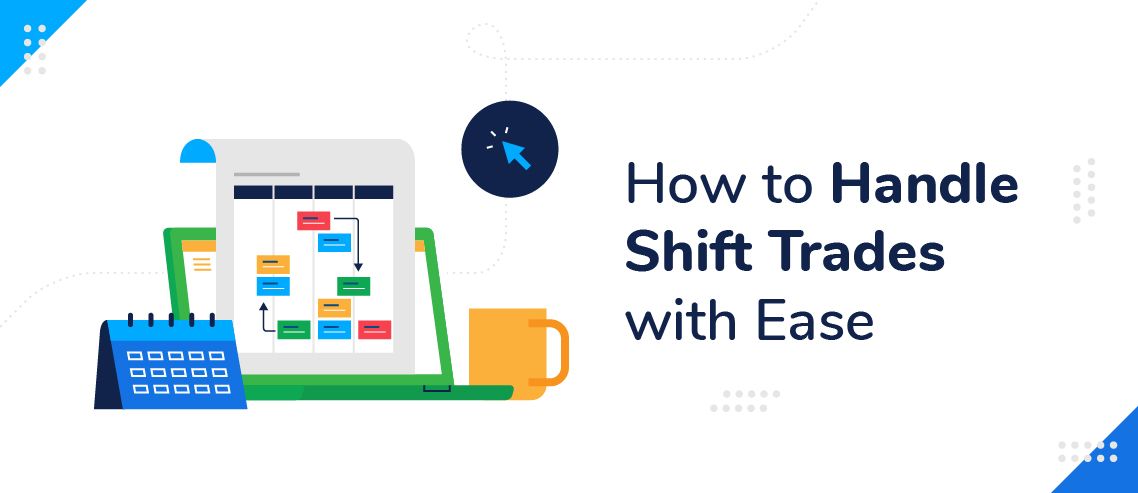How to Handle Shift Trades with Ease

Last-minute schedule changes are stressful for everyone.
The employee feels bad for missing a shift or asking for a change at the eleventh hour. The manager has to scramble to call down a list of employees to find someone to replace them.
And there’s little to no guarantee someone will step up to take the shift, which leaves a sour tone over the whole matter.
Thankfully, the whole thing is avoidable.
Not entirely, of course. Things will inevitably pop up, but there is most definitely a better way to handle shift trades. One that leaves employees and managers alike feeling empowered and satisfied.
Here are our top tips for handling shift trades with ease:
Develop a Comprehensive Shift Trade Policy
A great starting point is simply setting guidelines for everyone to follow. If your shift trading policy is ambiguous, or worse, non-existent, then you’re naturally going to deal with a wild west situation.
Some key sections to cover are:
- Do shift trades require manager consent?
- Is there a formal policy for shift trading?
- Is it via email or through a software program?
- Does it have to be “X” days in advance?
- Are there any restrictions to shift trading or blackout dates?
- If you require them to find coverage, what happens if they can’t?
- Can anyone cover a shift, or does it have to be someone with similar experience or responsibilities?
- How does overtime factor into shift trades? Can people work extra hours without actually trading? Essentially, picking up shifts versus just trading them.
Once your policy feels complete and ready to share, find a way to do so in person or over video chat. Implementing new procedures or making changes can often come with resistance and confusion, so it’s best to share them in an open setting where people can ask questions, and you can really drive the purpose home.
Follow-up on your meeting and share the policy document out in an email, on your company drive, or anywhere else you store company documents. People will naturally have to refer back to it from time-to-time, and it’s best to communicate its location upfront, so people adhere to it.
Implement an Open-Door Policy
Communication is often the greatest barrier to an easy shift trading process. People are often fearful that a manager will turn them down, so they either delay asking or make accommodations without you knowing.
To combat any uneasiness, it’s best to create and communicate that you have an open-door policy. Make it known there’s nothing to be afraid of and how much you value taking time off yourself. It doesn’t hurt to clearly articulate how time off helps the company and reiterate some benefits of taking time off on health, morale, and job satisfaction.
Be Proactive With Your Scheduling
Shift trades are inevitable. People get sick, family comes into town, or some obligation pops up last-minute, and they can’t avoid it. Naturally, you can’t completely prevent these kinds of changes to the schedule, but there are things you can do to mitigate such occurrences:
Schedule as far in advance as possible. The greater the heads up, the less likely there will be last-minute changes.
Employee scheduling software like ZoomShift makes it easier to craft the perfect schedule weeks or months in advance with its shift template features. It’s almost like copy and pasting from week to week, and the drag and drop feature makes it easy to make necessary changes.
Take a personal interest in your employees’ lives, and regularly ask about their schedule preferences so you’re well ahead of potential changes.
- Are they going back to school soon and require schedule flexibility?
- Are they getting a ride from someone temporarily, and that’s going to change soon?
- Will they have to start caring for a child or parent soon that requires a change to their schedule?
The closer you are with your staff, the more likely you’ll know this stuff well in advance.
Make it a habit to ask them to update their work preferences monthly or quarterly. Ask them if any changes to their personal lives might change and help them brainstorm ways to get ahead of it.
Sometimes just having the conversation of how they can take the bus when they can’t get a ride or how their neighbor can watch the kids for a few hours certain nights of the week will help cut down on shift trades or no-shows.
Invest in Employee Scheduling Software
If you’re looking to truly streamline your shift trading policies and procedures, then ZoomShift is your champion. With it, you’ll empower your employees with the flexibility to cover shifts on their own, so you don’t have to act as the middleman.
All the communication is in-app, so there’s no more calling down a list or sending out mass texts and emails on your own. Finally, once a shift’s taken over, the system will do all the admin work for you by updating the schedule for both employees and making sure the live schedule is updated, so everyone’s on the same page.
Beyond shift trading, ZoomShift will help you improve staff accountability by sharing out the schedule via text, email, and push notifications. It’ll also automatically remind employees individually with notifications telling them a shift is about to start.
Suppose your organization is larger or has complex needs. In that case, you can also benefit from the tiered leadership permissions that let supervisor and management respond to time-off requests and make shift changes, so one person isn’t stuck doing all of it.
ZoomShift takes the hard work out of shift trading so you can focus on what you do best. Try it free with a 14-day no credit card required trial.
JD enjoys teaching people how to use ZoomShift to save time spent on scheduling. He’s curious, likes learning new things everyday and playing the guitar (although it’s a work in progress).



